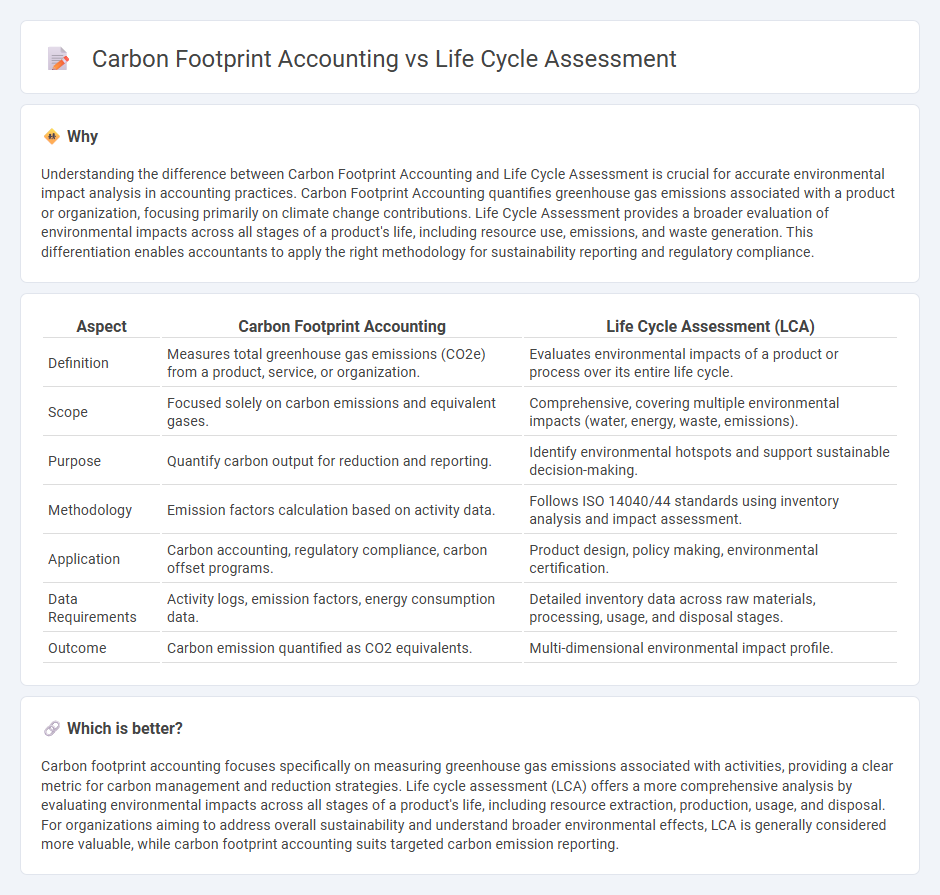
Carbon footprint accounting quantifies greenhouse gas emissions associated with a product, service, or organization, focusing on carbon dioxide equivalents to evaluate environmental impact. Life cycle assessment (LCA) offers a comprehensive analysis of environmental effects across all stages of a product's life, including resource extraction, production, use, and disposal. Explore further to understand how both approaches drive sustainable decision-making in accounting.
Why it is important
Understanding the difference between Carbon Footprint Accounting and Life Cycle Assessment is crucial for accurate environmental impact analysis in accounting practices. Carbon Footprint Accounting quantifies greenhouse gas emissions associated with a product or organization, focusing primarily on climate change contributions. Life Cycle Assessment provides a broader evaluation of environmental impacts across all stages of a product's life, including resource use, emissions, and waste generation. This differentiation enables accountants to apply the right methodology for sustainability reporting and regulatory compliance.
Comparison Table
| Aspect | Carbon Footprint Accounting | Life Cycle Assessment (LCA) |
|---|---|---|
| Definition | Measures total greenhouse gas emissions (CO2e) from a product, service, or organization. | Evaluates environmental impacts of a product or process over its entire life cycle. |
| Scope | Focused solely on carbon emissions and equivalent gases. | Comprehensive, covering multiple environmental impacts (water, energy, waste, emissions). |
| Purpose | Quantify carbon output for reduction and reporting. | Identify environmental hotspots and support sustainable decision-making. |
| Methodology | Emission factors calculation based on activity data. | Follows ISO 14040/44 standards using inventory analysis and impact assessment. |
| Application | Carbon accounting, regulatory compliance, carbon offset programs. | Product design, policy making, environmental certification. |
| Data Requirements | Activity logs, emission factors, energy consumption data. | Detailed inventory data across raw materials, processing, usage, and disposal stages. |
| Outcome | Carbon emission quantified as CO2 equivalents. | Multi-dimensional environmental impact profile. |
Which is better?
Carbon footprint accounting focuses specifically on measuring greenhouse gas emissions associated with activities, providing a clear metric for carbon management and reduction strategies. Life cycle assessment (LCA) offers a more comprehensive analysis by evaluating environmental impacts across all stages of a product's life, including resource extraction, production, usage, and disposal. For organizations aiming to address overall sustainability and understand broader environmental effects, LCA is generally considered more valuable, while carbon footprint accounting suits targeted carbon emission reporting.
Connection
Carbon footprint accounting quantifies greenhouse gas emissions associated with a product or organization, while Life Cycle Assessment (LCA) evaluates environmental impacts across all stages of a product's life. Both methodologies use data on resource consumption and emissions to provide comprehensive environmental performance metrics. Integrating carbon footprint accounting into LCA enhances accuracy in sustainability reporting and supports informed decision-making in accounting practices.
Key Terms
System Boundaries
Life cycle assessment (LCA) evaluates the environmental impacts of a product or process from raw material extraction to disposal, incorporating multiple impact categories, while carbon footprint accounting exclusively measures greenhouse gas emissions, often CO2 equivalents, within defined system boundaries. LCA's broad system boundaries encompass raw materials, production, use, and end-of-life phases, whereas carbon footprint accounting may have narrower scopes, focusing on scopes 1, 2, and sometimes 3 emissions depending on organizational or product-boundaries. Explore detailed methodologies and implications of system boundary choices for accurate environmental impact evaluations.
Emissions Inventory
Life cycle assessment (LCA) provides a comprehensive emissions inventory by evaluating the environmental impacts across all stages of a product's life, from raw material extraction to disposal, while carbon footprint accounting primarily focuses on quantifying greenhouse gas emissions associated with a specific activity or product. LCA incorporates multiple environmental categories beyond carbon emissions, offering a broader perspective on sustainability, whereas carbon footprint accounting offers precise measurement of CO2-equivalent emissions for targeted climate impact analysis. Explore detailed methodologies and case studies to understand the nuances between LCA and carbon footprint accounting.
Impact Categories
Life cycle assessment (LCA) evaluates multiple environmental impact categories including global warming potential, acidification, eutrophication, and resource depletion, providing a comprehensive view of a product's environmental performance. Carbon footprint accounting focuses primarily on quantifying greenhouse gas emissions expressed in CO2 equivalents to assess a product's or activity's contribution to climate change. Explore detailed comparisons to understand which approach best suits your sustainability goals and reporting needs.
Source and External Links
Life Cycle Assessment (LCA) explained - Life cycle assessment is a method for evaluating the environmental impacts of a product, process, or service across all stages--from raw material extraction to disposal or recycling--helping businesses make more sustainable decisions.
Life Cycle Assessment (LCA) - Everything you need to know - LCA measures the environmental impact of a product through every phase of its life, following standardized phases: goal and scope definition, inventory analysis, impact assessment, and interpretation.
Life-cycle assessment - LCA is a methodology for assessing the cumulative environmental impacts associated with all stages of a product's life cycle, from cradle to grave, following ISO 14040 and 14044 standards.
 dowidth.com
dowidth.com